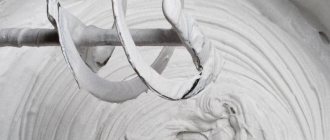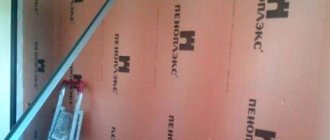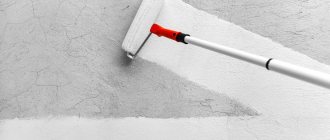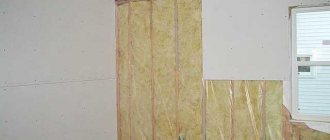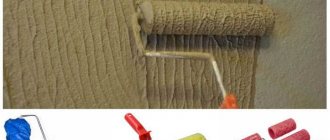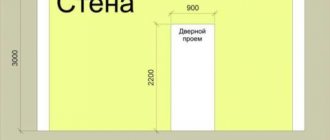What types of white are there and what are they used for?
Zinc white White
is prepared from zinc obtained by electrolytic method. The composition of white is zinc oxide ZnO. The white binder is a mixture of nut and linseed oils. Zinc white has a creamy tint. The streaks of zinc white are colder in tone than the streaks of lead white. The characteristic features of zinc white are that: a) they dry relatively slowly, b) they have average covering power, c) they improve the strength of paint mixtures. Under the influence of light, zinc white does not lose its whiteness; turn yellow in the dark, but the color gradually recovers when exposed to light. Under the influence of hydrogen sulfide and sulfur dioxide gases they do not lose their whiteness. The industrial production of zinc white dates back to 1849, when it was used in painting.
White lead
Lead whitening is prepared on the basis of lead carbonate. The binder for white lead is a mixture of nut and linseed oil. Lead white has less whiteness than zinc white, which makes it possible to obtain warmer whites. The characteristic features of lead white are that: a) they are a more viscous paste than zinc white; b) they dry much faster than zinc white (possessing drier properties), and in mixtures they accelerate the drying of other paints; c) have high hiding power and good adhesion; d) belong to toxic paints. Lead white is lightfast. Under the influence of hydrogen sulfide and sulfur dioxide gases, lead white darkens. Lead white has been used since the early Middle Ages. Note. The Leningrad Artistic Paints Plant produces the following white paints: zinc white, lead-zinc white, lead white, and titanium white, where the film-forming agent is specially treated oils or pentaerythritol esters of fatty acids of sunflower or linseed oils.
Titanium white.
Undesirable mixtures of white paints based on lead white
1. Mixtures of white lead with ultramarine, kaput-mortuum (light and dark), cobalt blue and violet, red speck and golden yellow “LC” are unacceptable. Mixing lead white with the listed paints causes their darkening or browning of tone. 2. Lead white in mixtures with violet kraplak, Van Dyck (Porkhovsky), as well as with black paints (especially with burnt bone), if mixed in small concentrations, less than 1:10, causes a sharp lightening of the paints. 3. Lead white should not be mixed with paints made with organic pigments. 4. In mixtures of lead white with dark violet cobalt, dark ocher, natural umber, dark transparent mars and light brown mars, the tone of the paints is lightened.
Source
Zinc white
Blanc de zinc. Zinkweiss, Chinesischweiss, Schneeweiss. Zinc white, flowers of zinc.
Due to the toxicity of white lead, attempts to make white paints from other materials have been made for a long time. So, already in 1780, Courtois prepared zinc white. Courtois's paint was very expensive, was not successful and was soon forgotten. Only in 1840 was it possible to obtain a cheap, non-poisonous paint from zinc that could compete with lead white in all respects; after this, the production of zinc white immediately stood on solid ground. Russian artists from the times of Borovikovsky, Levitsky, Bryullov and Al. Ivanov, therefore, were completely unfamiliar with this paint.
Zinc white is zinc oxide; their specific gravity is 5.6. 100 parts of zinc oxide contain 80.34% zinc and 19.66% oxygen.
Zinc white is produced by dry and wet methods, the first of which consists of the following: zinc metal is heated in special devices until it turns into vapor, which ignites in a stream of air directed at them and forms zinc oxide powder. This powder settles in the receiving chambers. The closest of them produces zinc oxide mixed with zinc metal powder, that is, sulfur paint (zincgrau), which is used in painting; in further chambers there is already a pure product. The zinc oxide is then calcined and pressed, which increases the hiding power of the paint.
In the second wet method, a solution of carbonic soda is added to the zinc sulfate solution until the formation of precipitate stops; the precipitate is zinc carbonate (sometimes sold under the name zinc white); it is washed, dried and calcined to remove carbon dioxide, i.e. to convert it into zinc oxide.
Pure zinc white is characterized by a bluish tint and absolute whiteness. Commercially available whites are not always endowed with these qualities. The purity of the product depends on the purity of the materials used for fabrication and the fabrication itself. If the zinc contained even the slightest traces of iron or cadmium, then the white takes on a yellow tint. When stored for a long time with access to air, zinc white absorbs carbon dioxide and water from it (good white contains no more than 2-3% water) and partially turns into zinc carbonate, becomes crystalline, loses its already weak hiding power and requires more oil. The white changed in this way is corrected by new calcination.
To protect zinc white (dry) from deterioration, it should be kept in some container without access to air, for example, in a bottle with a stopper, and it should be filled to the top with white.
White paints and the history of their creation
Much earlier than the advent of zinc white, humanity learned to make lead white. This type of paint was known to the ancient Greeks and Romans. Lead white was used everywhere until the 19th century.
Due to the toxicity of lead-based white paint, humanity has not given up attempts to create alternatives. This is how zinc white was invented. But, having appeared in 1780, they did not become widespread due to the high cost of their production process, and only 60 years later relatively cheap zinc-based white paints were obtained.
Following this, titanium white was discovered in 1912. These paints first appeared in Norway. Titanium white differs from other white paints in that it is completely non-toxic and has good covering properties.
Thus, new titanium and zinc compositions have replaced lead white.
Characteristics of white paints
Zinc white goes on sale in the form of ready-made or thickly rubbed paints. Thickly ground materials must be diluted with oil varnish before use. Other thinners are not suitable for this purpose, since as a result the painted surface will acquire a yellowish tint.
This material in its pure form is characterized by a snow-white color with a bluish tint. The quality and whiteness of this material depends entirely on the raw materials from which the pigment was obtained. This product should be stored covered, as it absorbs moisture from the environment. Zinc white pigments do not ignite and do not deteriorate under the influence of microorganisms.
This coloring material has a lot of positive qualities:
Zinc white has negative qualities:
Thickly ground white is used to obtain colorful compositions for coating wooden, metal and plastered surfaces of walls and ceilings.
Lead white had a pure snow-white color that did not lose its brightness when exposed to sunlight. The positive qualities of these paints include:
Lead white has disadvantages that have caused it to become less popular:
All these negative aspects have led to the fact that lead white is not used for industrial purposes.
Titanium white is advantageous because it:
Titanium compounds have one drawback: when dry, they create a brittle surface of the paint layer.
Alkyd paints were the latest to appear; they are the product of a complex chemical synthesis.
Application
Due to its high toxicity, lead white is not used in everyday life. To paint surfaces in order to isolate them from moisture, oil-based zinc white, alkyd and titanium compounds are used.
For painting plastered walls and ceilings, water-soluble paints based on zinc white are used. It should be noted that walls are now rarely painted white; most often this paint is used to cover the ceiling.
TEST METHODS
3.1. Sampling - according to GOST 9980.2.
3.2. Preparing samples for testing
The white to be tested is thoroughly mixed. The mass fractions of film-forming substance, solid substance, zinc compounds in terms of ZnO in the solid substance and the degree of grinding are determined without diluting the white. To determine other indicators, white is diluted to a painting consistency with natural drying oil in an amount of 17-28% by weight of thickly ground white, filtered through a sieve with mesh 056N GOST 6613 and applied with a brush to the prepared plates. Plates for applying white are prepared in accordance with GOST 8832, section 3. The color of the film and the drying time of the white are determined on plates made of steel grades 08 kp and 08 ps measuring 70x150 mm and thickness 0.5-1.0 mm according to GOST 16523 or on plates made of black cold-rolled sheet metal 0.25-0.28 mm thick according to GOST 13345. Film hardness is determined on glass for photographic plates measuring 9x12-1.2 according to TU 6-43-02-05133-03*. ________________ * Specifications mentioned here are not given. For more information please follow the link. — Note from the database manufacturer. To determine the drying time and hardness of the film, white is applied in one layer. The thickness of the single-layer coating after drying should be 25-30 microns. Film thickness is measured with a micrometer type MP-25 according to GOST 4381 or another device with an error of no more than ±3 µm. To determine the color, white is applied until the substrate is completely covered. Drying is carried out at a temperature of (20±2) °C for 24 hours (Changed edition, Amendment No. 1, 2).
3.3. The color of the dried white film is determined by visual comparison with the color of the corresponding control color samples in natural or artificial daylight scattered light. The samples being compared should be in the same plane at a distance of 300-500 mm from the observer’s eyes at a viewing angle that excludes surface gloss. In case of disagreement in color assessment, the color determination in natural daylight is taken as the final result. (Changed edition, Amendment No. 2).
3.4. The mass fractions of solid substance and film-forming substance are determined according to GOST 17537. A mixture of acetone (GOST 2768) with ethyl alcohol (GOST 17299) in a ratio of 3:2 is used as a solvent. The resulting solid is stored to determine the mass fraction of zinc compounds according to clause 3.5.
3.5. Determination of the mass fraction of zinc compounds in terms of ZnO in solid matter.
3.5.1. Reagents and solutions used: hydrochloric acid according to GOST 3118; aqueous ammonia according to GOST 3760, solution with a mass fraction of 25%; red Congo paper; distilled water according to GOST 6709; disodium salt of ethylenediamine-N,N,N'N'-tetraacetic acid, 2-water (trilon B) according to GOST 10652, solution concentration (1/2CHONNa 2HO) = 0.1 mol/dm, prepared according to GOST 10398, section .3 or from a fixed channel; ammonium chloride according to GOST 3773, chemical grade; buffer solution is prepared as follows: 20 g of ammonium chloride is dissolved in a small volume of water in a 1 dm3 volumetric flask, add 100 cm of ammonia solution. The volume of solution in the flask is adjusted to the mark with distilled water; eriochrome black T, indicator mixture, prepared according to GOST 10398, section 1.
3.5.2. Carrying out the test 0.5-1.0 g of the solid substance obtained according to clause 3.4, weighed in a glass accurate to the fourth decimal place, add 100-150 cm of distilled water, 15-20 cm of hydrochloric acid, heat and boil for 3- 5 minutes. After cooling, the solution is poured into a 250 cm3 volumetric flask and the volume is adjusted to the mark with distilled water, a 25 cm3 solution is pipetted into a 250 cm3 conical flask, neutralized with ammonia in the presence of Congo red paper, the precipitated white precipitate of zinc hydroxide is dissolved by adding a few drops of ammonia. Add 25-30 cm of distilled water to the solution, 10 cm of a buffer solution on the tip of a spatula of an indicator mixture and titrate with a 0.1 mol/dm solution of Trilon B until the color changes from red-violet to pure blue.
3.5.3. Processing of results The mass fraction of zinc compounds () as a percentage in terms of ZnO is calculated using the formula:
,
where is the volume of 0.1 mol/dm3 Trilon B solution used for titration, cm; — titer of 0.1 mol/dm Trilon B solution for metallic zinc (exactly 0.1 mol/dm Trilon B solution corresponds to 0.003269 g of zinc); 1.2447 is the coefficient for converting the mass of zinc to the mass of ZnO; — mass of a sample of a solid substance, g. The result of the determination is taken as the arithmetic mean of two parallel determinations, the permissible differences between which should not exceed 1%. The result is recorded accurate to the first decimal place.
3.5.1-3.5.3. (Changed edition, Amendment No. 2).
3.6. (Deleted, Amendment No. 2).
Characteristics
In its pure form, the product is absolutely white with a slight bluish tint. Whitewash is odorless and can also be mixed well with an aqueous solution of alkali and ammonia. They are not destroyed or deformed under the influence of microorganisms and bacteria. Since they are capable of absorbing moisture, they should only be stored in closed containers.
Positive properties also include indicators such as:
However, they also have negative properties, which include cracking, poor hiding power and the ability to absorb large amounts of oil.
When used in painting, such properties of white as fragility and the ability to become covered with cracks lead to the fact that paintings painted with its use cannot be folded. Moreover, you also need to monitor the tension of the canvas, which changes with increasing humidity. When it is compressed or stretched, the white may crumble.
Details Whitewash
Whitewashing is paint for whitening (with chalk, lime).
Whitewashing with slaked lime
Another way to finish the ceiling is whitewashing with slaked lime. Compared to whitewashing with ground chalk, lime whitewashing is stronger and more durable. It is resistant to water vapor and abrasion. It adheres well to plaster, brick and stone. Lime whitewashing is unacceptable on surfaces that contain rust, efflorescence, grease and bitumen stains. Before whitewashing the ceiling, the surface must be dust-free, surface cracks cleared, then primed, puttied and smoothed. Remove all mortar drips and delaminations. The base for whitewashing must be clean and strong, and before starting whitewashing it must be slightly moistened. If old whitewash has been applied to the surface, it must be cleaned with a brush, weak areas should be sanded off, and all cracks and depressions should be filled with putty. It is best to remove old whitewash, if any. It is best to whiten with lime mortar in the evening or on a cloudy day to avoid direct sunlight on the work surface. Lime whitewash has its advantages; the whitewashed ceiling has small pores that absorb water vapor, which then evaporates freely, exiting through these pores.
Composition of lime whitewash: Usually take 0.4 kg of lime and 0.6 liters of water for every 2.5 meters. If you want to make the whitewash better, add 0.3 tbsp to its composition. spoons of drying oil and 5 g of table salt. This whitewash will become more durable and water resistant. The mixture must be mixed well, strain through a sieve, remove lumps and impurities. It is best to add 20–25 g of ultramarine to the prepared lime milk to give the whitewash a slightly bluish tint. Typically this whitewash is applied in two thin layers. Moreover, the second layer needs to be covered with the still wet previous layer. Then the whitewash will be more durable. Lime mortar for whitewashing will be strong if the lime has time to carbonize. To do this, it is necessary that the lime whitewash retains moisture for some time, which is so necessary for carbonation. Therefore, before whitewashing with lime mortar, it is better to moisten the surface. It is recommended to add sodium chloride (table salt) and calcium chloride to the composition, since they are able to accumulate moisture from the air in the lime film and thereby maintain a humid environment, which is so necessary for normal crystallization of lime. Lime coating has disinfecting properties, which makes it suitable for certain areas. When the whitewash dries completely, a durable film that is resistant to abrasion is formed on its surface. Lime whitewash remains in good condition for at least 3 - 4 years, and by adding some components to its composition, the warranty period can be extended. When aluminum-potassium alum is added to lime compositions, the mechanical strength of whitewash is significantly improved. The strength of the lime film also depends on the type of lime used for whitewashing. Thus, a film on hot freshly slaked lime gives good strength within a week. The lime film acquires the greatest strength when whitewashed over a freshly applied layer of plaster.
Chalk whitewash
When carrying out whitewashing work, accuracy and prudence are very important. Having these qualities, you can count on a good result and a decent level of work performed. For example, 0.5 liters of liquid whitewash is enough for 1 m2 of surface. But such an expense is expected only if you have previously had experience in handling whitewash or a brush. Therefore, in order to avoid unwanted waste of material, it is necessary to practice applying whitewash. Otherwise, you risk splashing windows and furniture with the manufactured material, and also spending as much as 1.5 liters, and possibly more, on the process instead of the expected 0.5 liters. The amount of chalk or paste used for whitewashing consumed during repair work primarily depends on the quality of the materials you have chosen and on how the liquid whitewash made from them will be consumed. In order for the whitewash to be applied evenly, without gaps or streaks, the solution should be applied in two mutually perpendicular directions so that the layers intersect each other. If the surface has previously been whitewashed with lime, then it is not recommended to use chalk whitewash - you risk getting streaks and stains.
Composition of chalk whitewash: Whitewash, as well as primer and putty, can either be purchased at a specialized store or made at home yourself. But even if you bought the material in a store, you still have to prepare the solution. This means that it will need to be diluted with water, strained, and added coloring pigments if the need arises. For it you will need chalk or a special chalk paste, as well as a number of tools. You can buy chalk, the basic material in whitewash mortar, at any hardware store or company that sells building materials. It is usually sold in the form of a dry powder or paste. Powder and paste differ from each other in color. Chalk is white, and chalk paste has a grayish tint. When chalk paste whitewash dries, it will look as white as regular dry chalk. Dry chalk is perfectly preserved in almost any conditions without losing its properties. Chalk paste, unlike chalk, has one not very attractive feature. If it is stored for too long, it will acquire a pungent and unpleasant odor. But nevertheless, this “aroma” in no way affects
the quality of the material itself and the whiteness of the surface that is covered with it. For chalk whitewashing, prepare 5 liters of water heated to 40-50ºC and dissolve 30 g of wood glue in it, also add 3 kg of pre-sifted chalk. In order to prepare a higher quality whitewash, you need to include 2.3 kg of chalk, 90 g of wood glue, 17 g of ultramarine, 60 g of laundry soap and 3-4 liters of water. This volume of whitewash (based on the data provided) should be enough for a surface of 10 m2. By the way, under no circumstances should ultramarine be poured into liquid whitewash. If there is more of it than needed, the material will become hopelessly damaged. A small amount of ultramarine in powder form should be placed in a cloth bag. Then lower the bag of blue into a jar of water and “dissolve” it there, making movements with the bag as if you were stirring water. The longer ultramarine is in water, the more intense its color will be. This ultramarine solution should be added in small portions to cold whitewash. Achieve the desired shade of blue. In order not to put more bluing than required and thus avoid making a mistake with the color of the whitewash, dip any brush in the whitewash and make a few strokes on the white paper. When the samples have dried, you will be able to determine for yourself which color you like best and which one is better for whitewashing.
Ready whitewash (paste):
There is also ready-to-use whitewash. Outwardly, it looks like a thick plastic mass, which consists of a synthetic binder (carboxymethylcellulose, PVA dispersion), pigments, and moisture-proof additives. Dilute the finished whitewash with water, strictly adhering to the requirements set out in the instructions. After this, mix well to obtain a homogeneous substance. Apply the mixture to the ceiling in approximately 1-3 layers.
Like
Add a comment
Only registered users can leave comments. Swearing, flooding, insults of other users, and unreasoned statements are prohibited. Links to other sites and advertising, only with the permission of the administrator or employee of the company.
JComments
Types of zinc white
Zinc whitewash is divided into two grades: BTs0 and BTs1.
The product belonging to the BC0 brand is used for the manufacture of paints and varnishes, artificial leather and rubber products. It is also added to abrasive materials and cement compositions for dentistry.
Whitewash of the BC1 grade is mainly used for the production of asbestos-cement and paint and varnish materials, which are used for interior and exterior decoration of premises, and less often - for the production of artificial leather and sole rubber.
Application
In addition, there are other areas where zinc white is used. They are used in medicine. They are one of the components of some antiseptic ointments and powders. They are also used to make plastics, rubber, paper and glass.
Separately, we can highlight zinc white (white paint), made on the basis of zinc oxide grade A. This paint is divided into several types intended for external and internal work. Among this type of paint, zinc white MA 22 is most often used for interior decoration, which is characterized by high performance and increased fire safety.
In addition, today construction anti-corrosion paints are made from zinc white. Whitewash is added to putties and various adhesive compositions, and is also used in the production of ceramics.
SAFETY REQUIREMENTS
6.1. Whitewash is a fire hazardous and toxic material, which is due to the properties of the substances included in its composition. Lead compounds cause changes in the nervous system, blood, and blood vessels.
6.2. The fire hazard and toxicity characteristics of the components included in the white paint are given in Table 3.
Table 3
| Component name | Maximum permissible concentration in the air of the working area of industrial premises, mg/m | Temperature, °C | Concentration limits of ignition,% (by volume) | Hazard Class | |
| flashes | self-ignition | ||||
| Sunflower oil | — | 225-234 | 370-380 | — | — |
| Flaxseed oil | — | 240 | — | — | — |
| Soybean oil | — | 225-240 | — | — | — |
| Cottonseed oil | — | 232-234 | 370-380 | — | — |
| Natural drying oil | — | 220-280 | — | — | — |
| Dry zinc whitewash | 6 | — | — | — | 3 |
| Ultramarine | 10 | — | — | — | — |
| Barite concentrate | 6 | — | — | — | 4 |
| Talc | 4 | — | — | — | 4 |
| Lead compounds | 0,01 | — | — | — | 1 |
6.3. Precautionary measures during the manufacture and use of white: local and general ventilation, provision of workshop workers with special clothing and personal protective equipment that meet the requirements of GOST 12.4.011. To protect your hands, use pastes such as “biological gloves”.
6.4. During the production, use and testing of white, the requirements stipulated by the safety and industrial sanitation rules in accordance with GOST 12.3.005 must be observed.
6.5. Fire extinguishing agents: sand, felt, carbon dioxide, water, finely sprayed, chemical or air-mechanical foam from stationary installations or fire extinguishers. All work related to the manufacture, testing and use of white must be carried out in rooms equipped with supply and exhaust ventilation and fire-fighting equipment.
6.1-6.5. (Changed edition, Amendment No. 1).
6.6. In order to protect the atmospheric air from pollution by emissions of solvent vapors, constant monitoring of compliance with maximum permissible emissions (MPE) in accordance with GOST 17.2.3.02 must be organized. (Introduced additionally, Amendment No. 2). APPENDIX (reference). (Deleted, Amendment No. 1).
Oil-based zinc white
This product is zinc white, which is rubbed with drying oil or vegetable oil. They are often called oil paints and are used to protect metal structures from corrosion, as well as for painting wooden and plastered surfaces. Moreover, they are suitable for external and internal work.
Zinc white oil has good hiding power, that is, when applied to a surface, it completely hides the color of the previously applied coating. In addition, after application they create a durable anti-corrosion coating with high moisture resistance and vapor permeability.
Basics of the production of zinc white.
Zinc white is obtained either by oxidation of metallic zinc, or directly from zinc-containing raw materials.
In the first case, metallic zinc is melted in drum furnaces, it is evaporated and the vapors are oxidized with atmospheric oxygen. Let's consider the basic technological diagram for this method of producing zinc white (Fig. 1).
Rice. 1. Schematic diagram of the production of ZnO from zinc metal: 1 - device for supplying zinc and additives to the furnace; 2 - burner; 3 - drum rotary kiln; 4 - oxidation chamber; 5 - cyclone; 6 - filter.
Metallic zinc and, if necessary, additives are loaded into a rotating drum furnace 3, lined with refractory bricks. Heat for the melting and evaporation of zinc is supplied from the combustion products of natural gas in burner 2. Zinc vapor is discharged into the oxidation chamber 4, into which air is supplied. Zinc oxidation in the chamber proceeds according to the reaction:
.
The resulting zinc white is sent for collection into a cyclone 5 and a bag filter 6.
The most complex unit of the scheme is the drum furnace. It usually has a length of 1.7¸ 2.5 m and a diameter of 1¸ 1.5 m; speed - 0.5¸ 1 rpm. At the ends of the drum there are ring thresholds with a height of 250¸ 300 mm.
Zinc vapor must be removed from the furnace at a temperature of 1000¸ 1100 °C. The low temperature on the surface of liquid zinc leads to undesirable oxidation in the oven. As a result of this oxidation, a thick, loose layer of zinc oxide (“coat”) grows on the inner walls of the furnace. To clean the walls, the oven has to be stopped. To reduce unwanted oxidation of zinc, coke is added to the furnace using a device, which creates a protective gas layer with an increased concentration of CO above the liquid layer.
When producing zinc white from zinc-containing raw materials (zinc sulphide concentrate and zinc-containing industrial waste), use the scheme shown in Fig. 2.
Fig.2. Scheme for producing white from zinc-containing raw materials: 1 - bunker for coke; 2 - hopper for sinter; 3 – preparatory firing furnace; 4 - shaft electric furnace; 5 - oxidation chamber; 6 - cyclone; 7 - filter.
The essence of the technology for producing zinc white from agglomerate is as follows. The agglomerate and coke from bunkers 1 and 2 are pre-roasted in drum furnace 3, where at a temperature of 800 °C the raw material is freed from lead and cadmium. Then the zinc agglomerate granules enter electric furnace 4. The furnace is a cylindrical shaft with a diameter of 2.5 m and a height of 11 m. The furnace has 4 or 6 pairs of electrodes located along the height of the shaft. Zinc vapor from furnace 4 enters oxidation chambers 5, into which air is also supplied. The resulting zinc oxide is collected in cyclone 6 and bag filter 7. It should be noted that the productivity of such an installation is 30 tons of zinc white per day, and the electricity consumption per 1 kg of zinc oxide is 2.3 kW/h.
Painting method
Zinc whitewash is used to coat plastered, metal and wooden surfaces.
Work is carried out wearing rubber gloves, and during the work and after completion, the room must be ventilated.
Before you start painting, white, if it is a thickly ground powder, should be diluted with natural drying oil, the percentage of which should be 18–25% of the total mass of white, and mixed very thoroughly. If it is an oil paint, then, if necessary, white spirit or turpentine is added to it.
The surface should be pre-prepared:
To reduce the consumption of white, it is recommended to cover the surface with drying oil.
Apply whitewash to a dry, smooth surface using a paint brush, paint sprayer or roller:
The number of layers can be 1 or 2, depending on the desired result. Each layer usually takes 24 hours to dry if the room temperature is not lower than + 20º C. The consumption of white for one layer is approximately 170–200 g per 1 sq. m. m.
TECHNICAL REQUIREMENTS
1.1. Depending on the composition of the pigment part of the white, the following grades are produced with the corresponding OKP codes indicated in Table 1.
Table 1
| Brand | OKP code |
| MA-011-0 | 23 1711 1400 01 |
| MA-011-1 | 23 1711 0100 03 |
| MA-011-2 | 23 1711 0200 00 |
| MA-011-1N | 23 1711 0300 08 |
| MA-011-2N | 23 1711 0400 05 |
(Changed edition, Amendment No. 1).
1.2. Whitewash must be produced in accordance with the requirements of this standard according to the recipe and technological regulations approved in the prescribed manner.
1.3. Before use, the white is diluted with natural drying oil (GOST 7931).
It is allowed to dilute whitewash with drying oil “oxol” (GOST 190) or combined, while whitewash is used only for interior work.
1.4. In terms of physical and chemical parameters, thickly ground zinc white must meet the requirements and standards specified in Table 2.
table 2
| Indicator name | Standard for the brand | Test method | ||||
| MA-011-0 | MA-011-1 | MA-011-2 | MA-011-1N | MA-011-2N | ||
| 1. Film color | Must be within the permissible deviations established by color control samples | According to clause 3.3 | ||||
| 2. Mass fraction of solids, % | 84,0 -79,0 | 84,0 79,0 | 84,0 79,0 | 85,0 80,0 | 85,0 80,0 | According to GOST 17537 and clause 3.4 of this standard |
| 3. Mass fraction of film-forming substance, % | 16,0 -21,0 | 16,0 21,0 | 16,0 21,0 | 15,0 20,0 | 15,0 20,0 | According to GOST 17537 and clause 3.4 of this standard |
| 4. Mass fraction of zinc compounds in terms of ZnO in solid matter, % not less than | 98,0 | 96,0 | 86,0 | 73,0 | 65,0 | According to clause 3.5 |
| 5. Degree of grinding, microns, no more | 25 | 30 | 50 | 60 | 60 | According to GOST 6589 |
| 6. Covering power of an undried film of white molar consistency, g/m, no more | 170 | 170 | 170 | 200 | 200 | According to GOST 8784, section 1 |
| 7. Drying time to degree 3 at a temperature of (20±2) °C, h, no more | 24 | 24 | 24 | 24 | 24 | According to GOST 19007 |
| 8. Film hardness using a pendulum device, conventional units, not less | According to GOST 5233 | |||||
| type M-3 | 0,14 | 0,14 | 0,14 | 0,12 | 0,12 | |
| type TML (pendulum B) | 0,05 | 0,05 | 0,05 | 0,05 | 0,05 | |
Notes:
1. The film hardness standard for a pendulum device type M-3 is valid until 01/01/95.
2. The film hardness standard for a pendulum device of the TML type is not rejected until 01/01/95.
1.3, 1.4. (Changed edition, Amendment No. 1, 2).
1.5. (Deleted, Amendment No. 2).
Transportation and storage
The product can be transported by all types of covered transport, with the exception of whitewash packaged in special soft containers - they can be transported in open vehicles and also stored in open areas.
As for zinc white, packaged in other packaging, they must be stored only in closed warehouses, with temperatures ranging from –40 ºС to +40 ºС. They are placed on wooden pallets in stacks up to 3 m high.
Source


